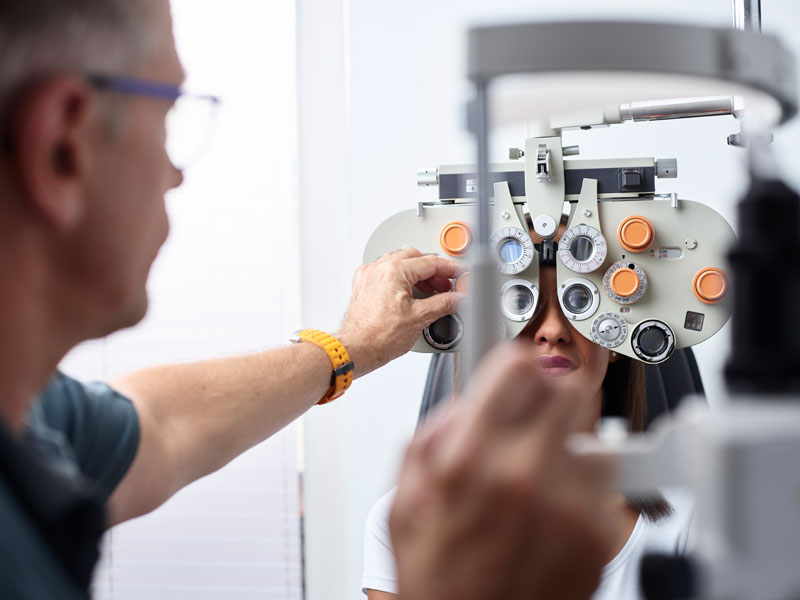Discovering the current Technical Developments in Optometry and What They Mean for Optometrists
In the ever-evolving field of optometry, current technological advancements are improving how practitioners come close to eye care. From the precision of Optical Comprehensibility Tomography to the nuanced insights offered by AI-driven analysis tools, these technologies are establishing new requirements in client evaluation and therapy. Teleoptometry is poised to redefine accessibility, ensuring that expertise goes beyond geographical limitations. As these developments penetrate the practice, optometrists are encountered with the challenge of welcoming these devices to improve patient results. The concern remains: exactly how will these technological changes redefine the roles and responsibilities within the career?
Technologies in Diagnostic Equipment
Progressing the field of optometry, advancements in analysis tools have revolutionized the way eye care experts evaluate and detect eye conditions and visual problems. The past decade has actually experienced significant technical improvements, allowing more thorough and precise assessments.
One more trick technology is the intro of sophisticated corneal topography systems, which map the surface curvature of the cornea with precision. These devices are specifically advantageous for suitable get in touch with lenses and detecting corneal conditions. Additionally, electronic retinal imaging has actually transformed typical ophthalmoscopy, using thorough, panoramic views of the retina that facilitate thorough visual assessments.
The advancement of wavefront aberrometry has actually additionally been important, enabling the analysis of refractive errors with unmatched accuracy (Opticore Optometry). This modern technology assists in personalizing rehabilitative lenses and enhancing medical end results for refractive surgical procedures. Collectively, these diagnostic improvements empower optometrists to supply superior client treatment, making sure very early intervention and customized therapy techniques, eventually boosting visual health and wellness results
AI in Person Management
Structure on the structure of innovative diagnostic devices, the unification of man-made intelligence (AI) in person monitoring stands for a transformative leap for optometry. AI systems are significantly utilized to boost performance, accuracy, and customization in client treatment.
Additionally, AI-driven platforms promote streamlined individual interactions and administrative procedures. Automated scheduling, virtual appointments, and customized follow-up strategies not only boost individual complete satisfaction yet also maximize time administration for practitioners. These systems can triage individuals based on the seriousness of their problems, making sure that those in essential need receive timely focus.
Additionally, AI enhances decision-making by giving optometrists with evidence-based recommendations and therapy pathways. By integrating information from electronic wellness documents, AI tools provide insights that inform medical choices, reducing the threat of errors and enhancing person outcomes. As AI continues to progress, its role in person management will likely expand, reshaping the landscape of optometric treatment.
Developments in Retinal Imaging
In the world of optometry, retinal imaging has actually witnessed impressive technological developments that are improving diagnostic capabilities and client treatment. Developments such as Optical Coherence Tomography (OCT) and fundus photography have transformed how optometrists envision and analyze the retina. OCT, particularly, supplies high-resolution, cross-sectional photos of the retina, permitting the comprehensive assessment of its layers. This capacity is very useful for very early discovery and monitoring of conditions like visit here glaucoma, diabetic person retinopathy, and age-related macular degeneration.
Enhanced imaging methods like OCT angiography are additional refining diagnostic precision. This non-invasive strategy maps blood flow in the retina, offering crucial insights right into vascular health without the demand for dye injections. In addition, adaptive optics technology is being integrated into retinal imaging systems to remedy eye aberrations, supplying extraordinary picture quality. Such improvements help with the identification of min retinal changes that could indicate disease development.
In addition, developments in artificial intelligence are increasing retinal imaging by enabling automatic evaluation of large datasets. These systems assist optometrists in determining patterns a measure of pathology, thereby improving analysis precision and efficiency. Collectively, these look at this site advancements are changing retinal imaging into a foundation of modern-day eye care, boosting results and broadening healing possibilities.
Teleoptometry's Expanding Role
Teleoptometry is increasingly becoming a vital part of eye treatment, driven by improvements in digital communication and analysis devices. This is specifically helpful in underserved and rural areas where accessibility to specialized eye treatment is often minimal.
The integration of synthetic knowledge (AI) more enhances teleoptometry, enabling the analysis of aesthetic data and assisting in the discovery of ocular conditions such as glaucoma and diabetic person retinopathy. AI-powered formulas can rapidly analyze intricate imaging information, supplying optometrists with important understandings that boost clinical decision-making.
Additionally, teleoptometry supports continuity of care via smooth combination with digital health and wellness documents (EHRs), allowing optometrists to preserve detailed patient histories. When seeking advice from with various practitioners., this makes sure that patients obtain consistent and individualized treatment also.
Regardless of these benefits, challenges continue to be, consisting of making sure data safety and security and handling client assumptions. Nevertheless, teleoptometry stands for a considerable stride towards even more easily accessible, reliable, and patient-centered eye care. As modern technology advances, its role is poised to broaden additionally.

Future Fads in Eye Care
A myriad of innovative patterns is readied to improve the future of eye treatment, driven by technical improvements and the advancing demands of individuals. One substantial fad is the integration of fabricated knowledge (AI) in diagnostics, which promises to enhance the accuracy and efficiency of eye exams. AI algorithms can assess large quantities of data from retinal pictures, potentially finding conditions like diabetic retinopathy and glaucoma earlier than standard techniques.
Moreover, individualized medicine is gaining grip in optometry, with hereditary screening educating tailored treatment strategies. This technique intends to enhance patient outcomes by customizing treatments to individual genetic profiles. Wearable technology, such as clever call lenses, is likewise coming up, supplying real-time monitoring of intraocular stress or sugar levels, hence supplying constant insights right into systemic and ocular health.
The adoption of augmented reality (AR) and online fact (VR) in training and client education and learning is another arising fad. These modern technologies supply immersive experiences that can boost understanding and skills both for people and eye doctors. As these patterns evolve, optometrists must stay abreast of technical innovations to provide sophisticated care, ensuring improved individual outcomes and fulfillment in the vibrant landscape of eye treatment.
Final Thought

Collectively, these diagnostic innovations equip optometrists to supply remarkable client treatment, making sure early treatment and customized therapy techniques, eventually enhancing aesthetic health end results.

As these modern technologies proceed to evolve, optometrists must adjust and incorporate them into technique, eventually optimizing process performance and raising the requirement of eye care delivered to clients.